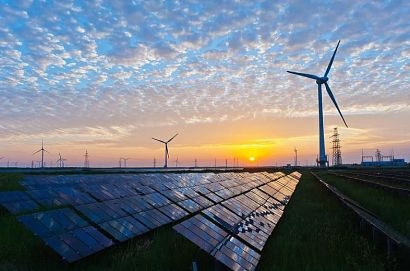
Renewable energy sources combined accounted for nearly two-thirds (64.1 percent) of the 16,886 MW of new utility-scale capacity added during the first three-quarters of this year. FERC's latest monthly Energy Infrastructure Update report (with data through 30th September 2020) also reveals smaller contributions from natural gas and very small contributions by coal with various other sources providing the balance. There have been no new capacity additions by nuclear power, oil, or geothermal energy since the beginning of the year.
Moreover, all of the 2,976 MW of new generating capacity added throughout the summer was provided by solar (1,484 MW), wind (1,468 MW), and hydropower (24 MW). In September alone, all new US electrical generation capacity added was attributable to two new ‘units’ of wind (159 MW) and five units of solar (36 MW).
Renewable energy sources now account for 23.3 percent of US total available installed generating capacity and continue to expand their lead over coal (20 percent). The generating capacity of just wind and solar is now more than 13.3 percent of the US total, and that doesn’t include distributed (rooftop) solar.
For perspective, five years ago, FERC reported that installed renewable energy generating capacity was 17.4 percent of the US total with wind at 5.9 percent (now 9.2 percent) and solar at 1.1 percent (now 4.1 percent). By comparison, in August 2015, coal's share was 26.6 percent (now 20.0 percent), nuclear was 9.2 percent (now 8.7 percent), and oil was 3.9 percent (now 3.3 percent). Only natural gas has shown any growth among non-renewable sources - expanding modestly from a 42.8 percent share five years ago to 44.5 percent today.
In addition, FERC data suggest that renewables’ share of generating capacity is on track to increase significantly over the next three years (i.e., by September 2023). High probability generation capacity additions for wind, minus anticipated retirements, reflect a projected net increase of 27,324 MW while solar is foreseen growing by even more - 32,801 MW. By comparison, net growth for natural gas will be only 20,872 MW. Thus, wind and solar combined are forecast to provide nearly three times as much new generating capacity as natural gas over the next three years.
While hydropower, geothermal, and biomass also are all projected to experience net growth (1,030 MW, 178 MW, and 116 MW respectively), the generating capacities of coal and oil are projected to plummet - by 22,346 MW and 5,023 MW respectively. In fact, FERC reports no new coal capacity in the pipeline over the next three years and just 6 MW of new oil-based capacity. Nuclear power is likewise forecast to drop sharply - by 4,990 MW, or nearly 5 percent of its currently operating capacity.
In total, the mix of all renewables will add more than 61,400 MW of net new generating capacity to the US total by September 2023 while the net new capacity from natural gas, coal, oil, and nuclear power combined will actually drop by almost 11,500 MW .
If these numbers hold, over the next three years, renewable energy generating capacity should account for comfortably more than a quarter of US total available installed generating capacity - increasing from 23.3 percent today to 27.2 percent three years hence. Meanwhile, coal's share will drop to 17.5 percent (from 20.0 percent today), nuclear to 7.9 percent (from 8.7 percent), and oil to 2.8 percent (from 3.3 percent). Natural gas' share will dip just slightly to 44.4 percent, compared to 44.5 percent now.
In fact, renewables’ share could - and probably will - be even higher. Over the past 20 months, FERC has been regularly increasing its renewable energy projections in the monthly Infrastructure reports. FERC's first such projection - provided in its March 2019 report - forecast the addition of 24,560 MW of wind and 12,048 MW of solar during the ensuing three years. In its most recent report, those forecasts had grown to 27,324 MW of new wind capacity and 32,801 MW of new solar over the next three years.
“There is no longer any doubt that renewable energy sources are already replacing coal, oil, and nuclear power while nipping at the heels of natural gas” said Ken Bossong, Executive Director of the SUN DAY Campaign. “In light of campaign promises made by President-elect Biden, this trend should not only continue but greatly accelerate in the year(s) to come.”
For additional information:

